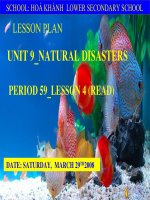UNIT 9 LESSON 4
Bạn đang xem bản rút gọn của tài liệu. Xem và tải ngay bản đầy đủ của tài liệu tại đây (1.44 MB, 29 trang )
MATCHING
1
2
3
4
A.Snowstorm
B.Earthquake
C.Volcano
D.Typhoon
Unit 9: NATURAL DISASTERS
Lesson 4: Reading - Page78
I. Vocabulary:
Unit 9: NATURAL DISASTERS
Lesson 4: Reading - Page78
I. Vocabulary:
- Tidal wave: (n)
Sóng thần
Unit 9: NATURAL DISASTERS
Lesson 4: Reading - Page78
I. Vocabulary:
- Tidal wave: (n)
Sóng thần
sudden
?
Unit 9: NATURAL DISASTERS
Lesson 4: Reading - Page78
I. Vocabulary:
- Tidal wave: (n)
Sóng thần
Sudden :
-abrupt : (adj)
Bất ngờ, đột ngột
- Shift : (n)
sự thay đổi , sự chuyển dịch
Unit 9: NATURAL DISASTERS
Lesson 4: Reading - Page78
I. Vocabulary:
- Tidal wave: (n)
Sóng thần
Sudden :
-abrupt : (adj)
Bất ngờ, đột ngột
- Shift : (n)
sự thay đổi , sự chuyển dịch
- tornado: (n)
Cơn lốc xoáy
II. True/False statements:
1. Most of the earthquakes in the world occur in
the Ring of Fire.
2. The earthquake in Kobe in 1995 caused severe
damage
3. A huge tidal wave traveled from California to
Alaska and hit Anchorage in the 1960s.
4. Typhoon, hurricane and tropical storm are
different words for the same natural disaster.
5. The eruption of Mount Pinatubo is the world
/
s
largest ever vocanic eruption
6. A tornado looks like a funnel.
T
T
F
T
F
T
Unit 9: NATURAL DISASTERS
Lesson 4: Reading - Page78
I. Vocabulary:
III.Read the text and complete the sentences:
1. The majority of earthquakes .............................................
2. During the earthquake in Kobe, many ..............................
3. A tidal wave can only occur when ....................................
4. In Australia, a tropical storm is known as ........................
5. The Chinese language gave us ........................................
6. A tornado is type of storm that...........................................
?
?
?
?
?
?









